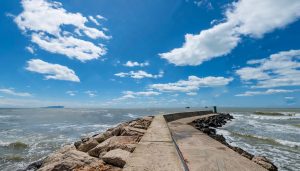As Pro Crew Schedule is starting to become a widely-used construction project management software, we are discovering more and more about the industry. And we’re seeing more construction projects kicking off on the coasts of the U.S. So today, we’d like to help budding firms in dealing with one of the major problems in coastal construction – corrosion in reinforced concrete.
The coast is becoming an in-demand location for small to mid-rise buildings. The location is great for businesses as many people are finding the value of traveling. That said, many hotels, restaurants, shopping centers and other businesses in the hospitality industry are considering a spot along the shore. Just look at the thriving businesses on the coastal towns of California, Connecticut, Delaware, and Florida among many others.
But while it’s definitely a prime spot for establishments, for construction, it may not be the case.
Challenges in Using Reinforced Concrete on Coastal Construction
Reinforced concrete is a versatile composite and remains to be one of the most widely used materials in modern construction. Concrete may be strong under compression but an unreinforced one is relatively poor at withstanding stresses that are brought about by wind loading, vibrations, and other factors. Obviously, this isn’t the ideal material in coastal construction.
To increase the strength of concrete, steel rods, wires, mesh or cables are embedded in concrete before it sets. This is called reinforcement or rebar and is used to resist tensile forces. And with the combination of concrete and reinforcement, the new material is now able to withstand a variety of applied forces.
However, reinforced concrete in the coastal areas is subjected to an extremely corrosive environment. The presence of chloride ions in seawater is what causes the corrosion. Plus the presence of oxygen can make the condition worse most especially during sea spray and splash.
Specifically, the corrosion of the reinforcing steel is the number one cause of deterioration of concrete buildings in the coastal zones. And deterioration often starts with the ingress of salt and moisture into the concrete. The causes? High permeability concrete, poor design detailing, and construction defects are some of the factors we can point out for this deterioration.
So as we always say, it is important to have everything designed properly and planned strategically before starting the construction. Consultation with suppliers and subcontractors specializing in reinforced concrete for coastal construction should be considered.
There should also be necessary measures to protect reinforced concrete structures in coastal areas. The use of blast furnace slag to improve concrete permeability is an example. Other measures include compacting concrete properly, considering various attacking sources in soil which is in direct contact with the structure, and utilizing proper curing regime.
Classification of Coastal Structure
To prepare for coastal construction, it will be helpful to analyze the project location and from there, plan the necessary measure to make your reinforced concrete structure last.
I – Based on Exposure
Concrete structures can be categorized into two based on their exposure to seawater.
1.Direct Exposure
Direct exposure refers to concrete structures in the coastal area that are fully or partially submerged like the floating cottages and hotels.
2.Indirect Exposure
Indirect exposure refers to structures that do not come into direct contact with seawater like the buildings along the coastline.
II – Based on Vis-a-vis Corrosion
Concrete structures can also be categorized with regard to their corrosion condition.
1.Submerged Zone
As its name suggests, the Submerged zone refers to structures with parts submerged under seawater. The corrosion of reinforced concrete in this zone is restricted by low oxygen, which in contrast, lowers chloride and moisture content or corrosion level.
2.Splash and Tide Zone
Reinforced concrete structures in this zone are intermittently wet and dry. They suffer from severe corrosion because of the alternate condition of wetting and drying. This change results in high chloride and oxygen content within the concrete.
3.Atmospheric Zone
Structures that are well above the high tide level are still subjected to corrosion because of airborne salts and moisture. The quality of the concrete and the depth of the covered portion of the structure play a major role in the ingress of chloride.
Protecting Reinforced Concrete from Corrosion
1.Ground Granulated Blast Furnace Slag and Portland cement
Regular steel has poor resistance against corrosion brought about by coastal conditions and hence requires protection for added durability. Instead of settling with this normal steel, you need to make it impermeable and dense to impede the penetration of chloride ions present in seawater. The combination of Ground Granulated Blast Furnace Slag (GGBS) and Portland cement can be used to achieve this and this is based on the IS 456:2000 recommendation.
2.Use High-Quality Materials in Making Concrete
The use of an adequate amount of cement, low water-cement ratio, and small-sized high-grade aggregates can make up a good quality concrete. This will benefit a structure in the coastal area as concrete must be dense with a good bond between aggregate and cement paste. And the mix we just mentioned makes this good dense concrete. Note that admixtures containing chlorides should not be used as they promote corrosion of reinforcement steels.
But apart from the use of high-quality materials in making concrete, it is also necessary to study the corrosion potential of soils in the coastal area where you are erecting the structure. Your study needs to look into soil chemistry, pH value of soil, subsoil temperature, soil mineral composition, effects of groundwater, microbial activity in soil oxidizing, or reducing the capacity of the soil. Know that the corrosion potential of the soil can attack the concrete, make it weak, or corrode the reinforcement in the structural members.
3.Meet Requirements of IS 456 on Concrete Mixture
Based on the exposure conditions of the structure on the coastal area, IS 456:2000 requires minimum cement content, a minimum grade of concrete, maximum W/C Ratio, nominal weight aggregates of 20mm nominal maximum size, fire resistance, and minimum concrete cover for durability to achieve quality concrete mixture.
4.Proper Concrete Compaction
We mentioned earlier that you need to make concrete impermeable and dense to minimize water penetration. This can be achieved through proper compaction of concrete. Problems may arise when placing and vibrating techniques are incorrect, reinforcement is congested, the slump is too low, or form shapes are not conducive to the necessary flow of concrete during placement.
5.Proper Curing of Concrete
Another way to achieve low permeability is the proper and sufficient curing of concrete. To explain, as the continued hydration of cement increases the volume of the gel, the pore spaces in the concrete are decreased and hence blocks capillaries where seawater can enter from.
Final Thoughts
It can be challenging to construct buildings along the coastline with the risks of corrosion at a high level. However, with the basic knowledge on how to prepare your reinforcement and concrete and proper design and planning, you can actually build a structure that will last on the coastline. So plan your coastal structures more efficiently with the help of Pro Crew Schedule construction project management software and team up with experts on concreting to see a new successful project by the shore.





